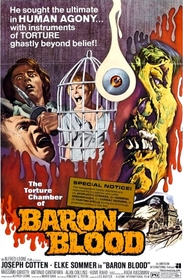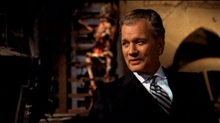Our editor-in-chief Nate Yapp is proud to have contributed to the new book Hidden Horror: A Celebration of 101 Underrated and Overlooked Fright Flicks, edited by Aaron Christensen. Another contributors include Anthony Timpone, B.J. Colangelo, Dave Alexander, Classic-Horror.com's own Robert C. Ring and John W. Bowen. Pick up a copy today from Amazon.com!
Baron Blood (1972)
Although there are still more films of his that I haven't seen than I have as of this writing (I'm catching up, though), when someone mentions Italian horror, the first name that I usually think of is Mario Bava.
I've consistently enjoyed Bava's films more than his Italian competitors - Dario Argento, Lucio Fulci, Ruggero Deodato, etc. - and Baron Blood is no exception. Although I like his competitors' films to an extent, and they all have masterpieces of their own, Bava seems to be more focused on his films' construction as a whole--the plot, the characterizations, the dialogue, etc. are all as important as the gore and style.
Baron Blood begins as the story of Peter Kleist (Antonio Cantafora), who has traveled back to his ancestral home of Austria, ostensibly to take a break from college after earning his Master's degree. As we quickly discover, however, he really headed back because he's intrigued--obsessed, almost--with the legend of Baron Otton von Kleist, a relative from 300 years ago who is a virtual reconstruction of Vlad the Impaler, the real-life source and inspiration of much of Bram Stoker's Dracula.
At this point, I was mildly hoping that Baron Blood would turn into a vampire film of sorts, as the vampire subgenre is one of my favorites, but Bava takes the film in a different direction, and pleasantly surprised me.
It seems that Peter has found an old scroll, supposedly written by a witch that's guaranteed to wake Baron Kleist, or "Baron Blood" as he's known to the locals, and make him suffer the same tortures that he put his victims through. Peter, through friends (possibly they were relatives and I missed it) in Austria, hooks up with Eva Arnold (Elke Sommer), an architectural restoration expert, and together they skeptically try to see if the witch's incantation will really work.
One of the first things you'll notice about Baron Blood is the great atmosphere. Bava's films always have crisp cinematography, and from the moment we first see Baron Blood's castle (like Vlad the Impaler, Baron Blood was apparently the political leader of the area in his time), Bava conveys both eerieness and beauty at the same time. Later scenes heighten the atmosphere, and Bava makes great use of fog to suggest the classic horror films from the 30's and 40's. In fact, the Baron Blood character himself seems like a forgotten classic monster--deserving of a place next to The Phantom, Dracula, Frankenstein, The Mummy, et al.
At the same time, you can read Baron Blood as more of a bridge between the classic films and the modern slashers, as there are many elements of the latter present. This may be even more apparent in the uncut version of Baron Blood, as the American version, which I ended up with, has eight minutes of cuts, at least some of which is supposedly gore shots. There was still some gore in the version I watched, and even with the cuts, it was bloodier than films like I Know What You Did Last Summer.
The American version of the film (90 minutes versus 98) also features a substitute score by Les Baxter. While I'm definitely going to search out the uncut version in the near future (and who knows, it may just raise my rating a half point or more), I have to say that the American version is worth seeking out as well, if only for Baxter's delightfully twisted organ music, which is what I imagine Church of Satan founder Anton LaVey's playing (he loved the organ) might have sounded like in his more manic, and less pop-oriented moments.
There is also a credit on the American version for scriptwriting that apparently isn't on the Italian version. I don't know Italian and can't lip-read well enough anyway to know how much of the script may have been changed, but presumably there can't be too much difference in this department or the scenes wouldn't match up. In any event, the dubbed English dialogue was excellent; it was both well-written and well-performed, featuring a pithy mythology, realistic conversations and it helped in the suspense department.
And there is plenty of suspense in Baron Blood. All the scenes in the castle are intense, especially when Peter and Eva first look for secret passageways and when they read the incantation for the first time in the "burned room." The latter scene is as thrilling as horror films can get, and Bava gets all the elements--setting, lighting, construction, directing the actors, editing, etc.--just right.
Unfortunately, Baron Blood isn't a perfect film, although it was on track to be for at least the fist 45 minutes or so. There are two minor flaws. One is that there is a section, near introduction of the witch and the stalking of the Hummel girl, that loses focus slightly and takes a misstep or two in pacing. The other, and this may be the transfer, is that a couple night scenes are too dark. Some night scenes are dark and should be that way, but at least two make us lose sight of necessary action. The best bet in these scenes, if the problem isn't with the transfer, would have been to employ the Argento-ish, surreal, ambient lighting that Bava so effectively used in the scene where Eva is running through the night streets in the fog.
Baron Blood is not a masterpiece, but it's close, and the uncut version may be closer. In any event, it's without a doubt an eerie, atmospheric, intelligent film by one of the godfathers of the genre, and as such, you shouldn't miss it.









